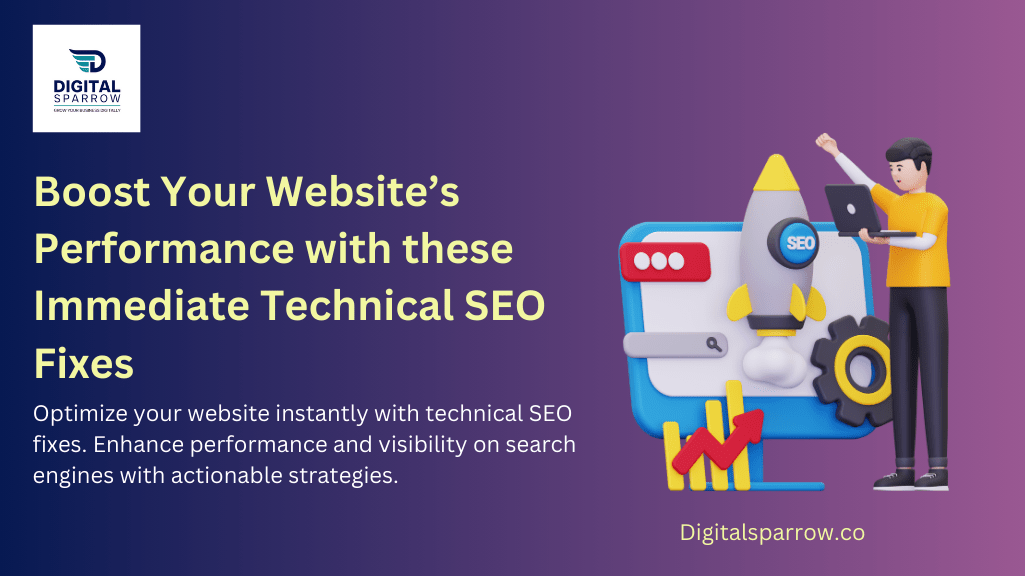Introduction
In the competitive world of online marketing, having a visually appealing website with compelling content is just the beginning. To truly succeed, your website must perform well in search engine rankings. This is where Technical SEO (Search Engine Optimization) comes into play. Technical SEO focuses on the behind-the-scenes aspects of your website that can significantly impact its search visibility and user experience.
We’ll look at a few quick Technical SEO adjustments that can help your website operate better and rank higher in search engine results pages (SERPs). These improvements are doable, and by implementing them, you may improve the visibility, user experience, and overall success of your website.
Optimize Page Loading Speed
Website speed is crucial for both user satisfaction and SEO rankings. Slow-loading pages can drive visitors away and negatively impact your search rankings. To optimize page loading speed:
- Compress Images: Use image compression tools to reduce file sizes without sacrificing quality.
- Minimize HTTP Requests: Combine and minimize CSS and JavaScript files.
- Leverage Browser Caching: Set up caching to reduce load times for returning visitors.
- Use Content Delivery Networks (CDNs): CDNs distribute your content across multiple servers, reducing latency for users worldwide.
Ensure Mobile Responsiveness
Google places a high value on mobile usability. Your website must be responsive and offer a consistent user experience on mobile devices. To accomplish this, follow these steps:
- Implement Responsive Design: Use responsive web design approaches to ensure that your site adjusts to different screen sizes.
- Test on Mobile Devices: Run regular tests on your site on various mobile devices to identify and resolve any issues.
- Optimise Images for Mobile: To reduce load times, ensure that images are correctly scaled for mobile screens.
Fix Broken Links
Fixing broken links is an important chore for website maintenance and improving user experience. Broken links, often known as 404 errors, occur when a hyperlink connects to a web page or resource that is no longer available or has been relocated. Here’s why and how to deal with them:
- User Experience: Broken links frustrate visitors, disrupt navigation, and can lead to a negative perception of your site.
- SEO Impact: Search engines like Google consider broken links as a sign of poor website quality, potentially affecting your search rankings.
To fix broken links:
- Regularly Audit: Use tools like Google Search Console, online broken link checkers, or website crawlers to identify broken links.
- Update or Remove: Either update the link to connect to the right resource or remove it if the content is no longer available.
- Implement Redirects: If a page has been permanently moved or renamed, put up 301 redirects to the new URL.
By proactively correcting broken links, you may increase customer pleasure, preserve SEO credibility, and offer a more seamless browsing experience on your website.
Implement HTTPS
HTTPS is critical for website security and SEO. HTTPS encrypts data between users and your website, protecting important information. This encryption also fosters visitor trust. HTTPS sites are prioritised by search engines like Google, potentially improving your SEO rankings. To use HTTPS, obtain an SSL certificate from a reputable certificate authority (CA) and install it on your web server. Change all internal and external links to “https://” and make sure canonical tags point to the HTTPS version of your site. This easy but crucial step improves security, user confidence, and search engine visibility.
Google Analytics 4 : https://digitalsparrow.co/google-analytics-4-ga4-migration-guide/
Optimize Your XML Sitemap
Optimizing your XML sitemap is essential for improving your website’s visibility in search engines. A well-organized XML sitemap helps search engine crawlers understand your site’s structure, leading to more effective indexing. Check that it contains all important pages, prioritises high-value material, and follows search engine rules. Update and submit your XML sitemap on a regular basis through Google Search Console or other appropriate platforms to aid in accurate indexing and improve your site’s search engine performance.
Improve URL Structure
Improving the URL structure of your website is a critical step in improving both user experience and search engine optimisation (SEO). A well-structured URL can transmit information about a page’s content and organisation, making it more accessible to people and search engines alike. Here’s why you should update your URL structure and how to do so:
Benefits of a Good URL Structure:
- User-Friendly: Clean, concise URLs are easier for users to read, understand, and remember.
- SEO-Friendly: Search engines prefer URLs that include relevant keywords and accurately represent the content.
- Crawlability: Logical URL structures make it simpler for search engine bots to crawl and index your site.
- Shareability: Neat URLs are more shareable on social media and in links.
Tips for Improving URL Structure:
- Descriptive Keywords: Include relevant keywords in your URLs, but keep them concise.
- Use Hyphens: Separate words in URLs with hyphens (-) rather than underscores or spaces.
- Hierarchy: Create a logical hierarchy with subfolders to organize content.
- Avoid Stop Words: Remove unnecessary words like “and,” “the,” or “in” from URLs.
- Static URLs: Use static URLs instead of dynamic ones with complex query parameters.
By optimizing your URL structure, you not only improve SEO but also make it easier for users to navigate your site, resulting in a more user-friendly and search engine-friendly web presence.
Optimize Header Tags and Meta Descriptions
Optimising header tags (H1, H2, H3, etc.) and meta descriptions is a critical component of on-page SEO. These aspects not only increase search engine comprehension but also improve user experience, making your material more desirable in search results. Here’s why and how to optimise them effectively:
Header Tags:
- Hierarchy and Structure: Header tags establish a clear content hierarchy, guiding both users and search engines through your page’s structure.
- Keyword Placement: Include relevant keywords naturally in header tags to signal the topic of each section.
- Readability: Ensure headers are concise, descriptive, and easy to read.
Meta Descriptions:
- Click-Through Rate (CTR): A well-written meta description might persuade users to click on your link in search results, thereby increasing CTR.
- Relevance: Match meta descriptions to the page’s content to ensure uniformity and intelligibility.
- Call to Action (CTA): Include an enticing CTA to entice users to visit your site.
Audit and update header tags and meta descriptions on a regular basis to line with the focus and relevance of your content. These minor but important changes can significantly boost your site’s exposure and user engagement in search engine results.
Eliminate Duplicate Content
Duplicate content elimination is a vital component of efficient SEO and user experience optimisation. Duplicate content can confuse search engines, dilute your site’s authority, and result in a poor user experience. Here’s why and how to deal with this problem:
- SEO Advantages: Search engines attempt to give original and valuable content to visitors. Duplicate content may cause search engines to index the incorrect version of a page, thereby damaging your site’s visibility in search results.
- Crawl Efficiency: Duplicate content can waste search engine resources as crawlers attempt to index several identical pages.
- User Confusion: Duplicate content can confuse users, resulting in a frustrating experience and greater bounce rates.
To eliminate duplicate content:
- Canonical Tags: Use canonical tags to specify the preferred version of a page when there are duplicates.
- 301 Redirects: Redirect duplicate URLs to the canonical version to consolidate SEO authority.
- Consolidate Similar Content: Combine similar pages into one comprehensive piece, enhancing user experience and reducing duplication.
- Regular Audits: Periodically audit your site for duplicate content, using tools like Screaming Frog or website crawlers.
By proactively eliminating duplicate content, you can guarantee that your website provides a clear, distinctive, and meaningful experience to both visitors and search engines, thereby enhancing your SEO rankings and user happiness.
Improve Internal Linking
Improving internal linking is an important part of improving your website’s user experience and SEO. Internal links are connections between pages on your website that play an important function in navigating readers through your content and distributing SEO authority. Here’s why and how to improve internal linking:
- Enhanced User Navigation:Internal links that are well-structured make it easier for users to access similar information, lowering bounce rates and increasing time on site.
- Improved SEO: Internal links make it easier for search engine crawlers to identify and index your content. They also share link equity (PageRank), which helps linked pages rank higher.
- Content Relevance: Connect relevant anchor text to linked pages, signalling to search engines the context and importance of the information.
- Create Topic Clusters: With a pillar page (complete guide) and connected sub-pages, organise relevant content into topic clusters to reinforce your site’s authority on key topics.
- Regular Audits: Periodically audit and update your internal links to maintain accuracy and relevance.
- User Journey: Consider the user journey and guide visitors towards conversion points using strategic internal links.
By prioritizing internal linking, you can improve user engagement, strengthen your site’s SEO foundation, and ultimately enhance your website’s overall performance in search engine rankings.
Niche Marketing: https://startupadvice.in/niche-marketing-your-guide-to-success/
Fix Crawl Errors
Fixing crawl errors is crucial for a healthy website. These flaws, discovered by search engine crawlers such as Googlebot, impede the indexation and visibility of your website. Broken links, server failures, and inaccessible pages are among them. To fix crawl errors, do the following:
Identify Issues: Use tools like Google Search Console to pinpoint crawl errors on your site.
Fix Broken Links: Replace or redirect broken links to functional pages.
Resolve Server Errors: Investigate and fix server-related issues to ensure accessibility.
Remove Duplicate Content: Eliminate duplicate pages, clarifying the site’s structure for crawlers.
Regularly addressing crawl errors ensures smooth indexing and improves your website’s search engine performance.
Conclusion
Technical SEO is a critical aspect of ensuring your website ranks well in search engines and provides an optimal user experience. You may improve your website’s performance, increase its exposure in search results, and eventually attract more organic visitors to your site by applying these fast technical SEO adjustments. Keep in mind that SEO is a continuous process, and remaining current with best practises is critical to long-term success in the digital arena.


Your point of view caught my eye and was very interesting. Thanks. I have a question for you.
Thank you for your sharing. I am worried that I lack creative ideas. It is your article that makes me full of hope. Thank you. But, I have a question, can you help me?
Can you be more specific about the content of your article? After reading it, I still have some doubts. Hope you can help me.